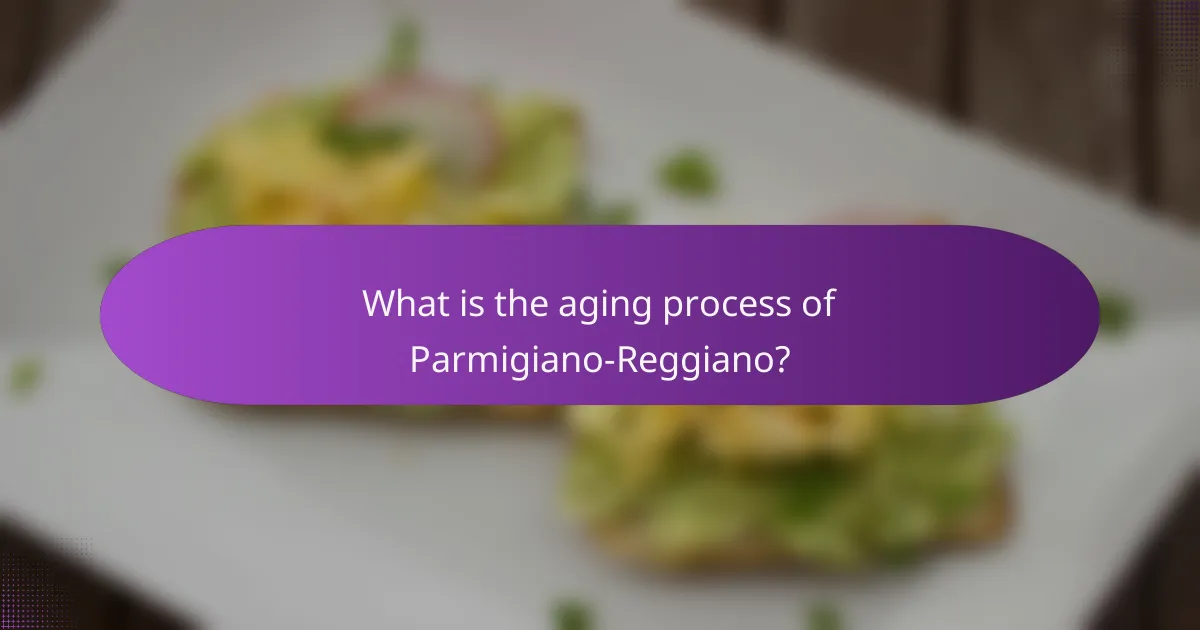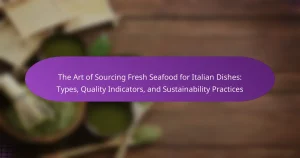
What is Parmigiano-Reggiano?
Parmigiano-Reggiano is a hard, granular cheese produced in specific regions of Italy. It is made from cow’s milk and aged for a minimum of 12 months. This cheese is known for its rich flavor and distinctive texture. It has a nutty, savory taste that intensifies with aging. Parmigiano-Reggiano is often grated over pasta dishes, salads, and soups. It is a key ingredient in many Italian recipes. The production process is strictly regulated to ensure authenticity. Only cheese made in designated areas can be labeled as Parmigiano-Reggiano.
How is Parmigiano-Reggiano produced?
Parmigiano-Reggiano is produced through a meticulous process involving specific ingredients and techniques. The production begins with high-quality raw cow’s milk from designated regions in Italy. The milk is heated and combined with natural whey starter cultures. Rennet is then added to curdle the milk.
Once curdled, the curds are cut into small pieces and cooked to release whey. The curds are then drained and placed into molds to form wheels. Afterward, the wheels are brined in a salt solution for flavor and preservation.
Aging occurs for a minimum of 12 months, during which the cheese develops its distinct flavor and texture. Parmigiano-Reggiano is regularly inspected during aging to ensure quality. The final product is a hard cheese known for its rich, savory taste and granular texture.
What are the key ingredients in Parmigiano-Reggiano?
The key ingredients in Parmigiano-Reggiano are cow’s milk, salt, and rennet. Cow’s milk is the primary component, sourced from specific breeds of cows in designated regions of Italy. Salt is added for flavor and preservation during the cheese-making process. Rennet, an enzyme, is used to curdle the milk, facilitating the formation of cheese. These ingredients must adhere to strict regulations to ensure authenticity and quality, as outlined by the Consorzio del Formaggio Parmigiano-Reggiano.
What is the significance of the production location for Parmigiano-Reggiano?
The production location for Parmigiano-Reggiano is crucial for its authenticity and quality. This cheese must be produced in specific regions of Italy: Parma, Reggio Emilia, Modena, and parts of Bologna and Mantua. The unique climate and grass of these areas contribute to the cheese’s distinct flavor profile. Additionally, strict regulations govern the production process, ensuring consistency and quality. The Protected Designation of Origin (PDO) status further emphasizes the importance of location. This designation guarantees that only cheese made in these regions can be labeled as Parmigiano-Reggiano. Thus, the production location is integral to maintaining the cheese’s heritage and reputation.
Why is Parmigiano-Reggiano important in Italian cooking?
Parmigiano-Reggiano is crucial in Italian cooking due to its distinct flavor and versatility. This cheese enhances a variety of dishes, from pasta to risottos. Its aging process, lasting a minimum of 12 months, develops complex flavor notes. The cheese’s granular texture allows it to be easily grated or shaved. Parmigiano-Reggiano is also a key ingredient in traditional recipes like pesto and lasagna. Its authenticity is protected by strict regulations, ensuring quality and tradition. This cheese is often referred to as “the king of cheeses” in Italy. Its rich umami flavor profile elevates the taste of many Italian dishes.
How does Parmigiano-Reggiano enhance the flavor of Italian dishes?
Parmigiano-Reggiano enhances the flavor of Italian dishes through its rich, nutty taste. This cheese is aged for a minimum of 12 months, developing complex flavor notes. Its crystalline texture adds a delightful crunch to dishes. The umami profile of Parmigiano-Reggiano amplifies the overall taste of recipes. It works well in both savory and sweet dishes, providing versatility. Studies show that its flavor compounds can elevate the taste perception of other ingredients. Additionally, it serves as a finishing touch, enhancing presentation and aroma. The authenticity of Parmigiano-Reggiano, protected by its designation of origin, ensures consistent quality in flavor.
What traditional Italian recipes feature Parmigiano-Reggiano?
Traditional Italian recipes that feature Parmigiano-Reggiano include Risotto alla Milanese, Lasagna, and Pasta al Forno. Risotto alla Milanese uses the cheese to enhance its creamy texture and flavor. Lasagna incorporates layers of Parmigiano-Reggiano between sheets of pasta and meat sauce. Pasta al Forno is a baked pasta dish that often includes grated Parmigiano-Reggiano for added richness. These recipes highlight the cheese’s role in Italian cuisine. Parmigiano-Reggiano is known for its nutty flavor and granular texture, making it a staple in many traditional dishes.

What is the aging process of Parmigiano-Reggiano?
The aging process of Parmigiano-Reggiano lasts a minimum of 12 months. During this time, the cheese is stored in controlled environments. Temperature and humidity are carefully monitored. The cheese develops its characteristic flavor and texture as it ages. At 12 months, it is considered “Parmigiano-Reggiano.” Longer aging periods enhance its complexity. Cheeses aged for 24 months or more exhibit richer flavors. Some wheels are aged up to 36 months or longer for an intense taste. The aging process is crucial for developing the cheese’s unique profile.
How does the aging process affect the flavor profile of Parmigiano-Reggiano?
The aging process significantly enhances the flavor profile of Parmigiano-Reggiano. As the cheese matures, it develops a complex range of flavors. Younger Parmigiano-Reggiano has a milder taste with creamy and nutty notes. Aging for 12 to 24 months introduces sharper, more pronounced flavors. Beyond 24 months, the cheese becomes more granular and develops crystalline textures. These crystals are a result of amino acid breakdown, contributing to a rich umami flavor. The aging process also intensifies the cheese’s savory and fruity notes. Research shows that flavors evolve through enzymatic and microbial activity during aging. This complexity makes aged Parmigiano-Reggiano highly sought after in culinary applications.
What are the different aging stages of Parmigiano-Reggiano?
Parmigiano-Reggiano has several distinct aging stages. These stages are classified based on the duration of aging. The first stage is 12 months, resulting in a mild flavor and a firm texture. The second stage is 24 months, where the cheese develops a more pronounced taste and a granular texture. The third stage is 36 months, characterized by a rich, complex flavor and a crunchy texture due to protein crystals. Some Parmigiano-Reggiano can age even longer, exceeding 36 months, which enhances its depth of flavor and aroma. These aging stages contribute significantly to the cheese’s culinary versatility and authenticity.
How long is Parmigiano-Reggiano typically aged?
Parmigiano-Reggiano is typically aged for a minimum of 12 months. Most commonly, it is aged between 18 to 24 months. Some varieties can be aged for up to 36 months or longer. The aging process enhances its flavor and texture. This cheese undergoes a meticulous production process in specific regions of Italy. The aging contributes to its characteristic granular texture and complex flavor profile.
Why is the aging process crucial for quality?
The aging process is crucial for the quality of Parmigiano-Reggiano. Aging enhances flavor complexity and texture. As the cheese matures, enzymes break down proteins and fats. This process creates rich, nutty flavors and a granular texture. The minimum aging period is 12 months, but many varieties age for 24 months or longer. Studies show that longer aging results in more pronounced flavor profiles. The aging environment also impacts quality, as temperature and humidity play significant roles. Overall, aging transforms Parmigiano-Reggiano into a premium culinary ingredient.
What chemical changes occur during the aging of Parmigiano-Reggiano?
During the aging of Parmigiano-Reggiano, significant chemical changes occur. Proteins break down into peptides and amino acids through proteolysis. This process enhances flavor complexity and contributes to umami taste. Lipids also undergo lipolysis, resulting in free fatty acids that add to the cheese’s aroma. Lactose is converted into lactic acid, lowering pH and affecting texture. These changes lead to the formation of characteristic crystals, primarily calcium lactate. Over time, moisture content decreases, concentrating flavors and altering texture. These chemical transformations are essential for developing Parmigiano-Reggiano’s unique taste and quality.
How does aging influence the texture of Parmigiano-Reggiano?
Aging significantly influences the texture of Parmigiano-Reggiano. As the cheese matures, moisture content decreases. This results in a firmer and more granular texture. The aging process typically lasts between 12 to 36 months. Longer aging leads to a more complex texture. The cheese develops a crystalline structure due to amino acid crystallization. These crystals contribute to a crunchy mouthfeel. Additionally, aging enhances the cheese’s depth of flavor. The texture becomes more pronounced with time, making it ideal for grating and pairing with various dishes.

What are the flavor notes of Parmigiano-Reggiano?
Parmigiano-Reggiano has complex flavor notes that include nutty, savory, and slightly sweet characteristics. The cheese is known for its rich umami taste. It also features hints of fruitiness and a slight spiciness. The aging process enhances these flavors, with older cheeses developing deeper and more pronounced notes. Parmigiano-Reggiano is often described as having a granular texture that complements its flavor profile. The cheese’s unique taste results from the specific diet of the cows and the traditional production methods. These factors contribute to its designation as a high-quality cheese.
What are the primary flavor characteristics of Parmigiano-Reggiano?
Parmigiano-Reggiano is known for its rich, savory flavor. It has a strong umami profile that enhances many dishes. The cheese exhibits nutty and fruity notes. It also has a slightly grainy texture due to its aging process. The flavors intensify with age, developing deeper complexity. Aged varieties can have hints of caramel and butterscotch. The balance of saltiness contributes to its overall taste. These characteristics make it a versatile ingredient in Italian cooking.
How do the flavor notes vary with different aging times?
The flavor notes of Parmigiano-Reggiano vary significantly with aging times. Young Parmigiano-Reggiano, aged for 12 to 24 months, exhibits milder, creamier flavors with hints of fresh milk and butter. As it matures beyond 24 months, the cheese develops a more complex profile. Aged 24 to 36 months, it starts to show nutty and fruity notes, along with a firmer texture.
At 36 months and beyond, Parmigiano-Reggiano takes on deeper flavors, including savory, umami, and crystalline textures. This aging process enhances its aromatic qualities, resulting in a more pronounced flavor. The combination of aging and the specific conditions of production contribute to these variations. Studies indicate that the aging process significantly influences the sensory attributes of the cheese, making each age unique.
What tasting notes can one expect from high-quality Parmigiano-Reggiano?
High-quality Parmigiano-Reggiano offers a complex flavor profile. It typically presents nutty, savory, and slightly sweet notes. The cheese has a rich umami flavor, enhanced by its aging process. Aged varieties develop crystalline textures and a more intense taste. Some may also detect hints of fruitiness or grassiness. The cheese’s flavor can vary based on the cow’s diet and the production methods. Overall, the tasting notes reflect its artisanal craftsmanship and aging duration, often ranging from 12 to 36 months or more.
How do flavor notes impact culinary pairings?
Flavor notes significantly influence culinary pairings by determining complementary and contrasting tastes. Different flavor notes, such as nutty, fruity, or savory, guide chefs in selecting ingredients that enhance the overall dish. For example, the nutty flavor of Parmigiano-Reggiano pairs well with sweet fruits like figs or pears. This pairing balances the richness of the cheese with the sweetness of the fruit. Additionally, flavor notes help in creating harmony in dishes. Dishes featuring umami-rich ingredients often benefit from acidic elements, which can brighten the overall flavor profile. The careful consideration of flavor notes can elevate a dish’s complexity and enjoyment.
What wines pair well with Parmigiano-Reggiano?
Red wines such as Chianti and Barolo pair well with Parmigiano-Reggiano. These wines complement the cheese’s rich, nutty flavors. White wines like Sauvignon Blanc and Chardonnay also enhance its taste. The acidity in these wines balances the cheese’s saltiness. Sparkling wines, especially Prosecco, can provide a refreshing contrast. The bubbles cleanse the palate between bites. Overall, wines with good acidity and complexity are ideal choices.
Which dishes are best complemented by the flavors of Parmigiano-Reggiano?
Pasta dishes are best complemented by the flavors of Parmigiano-Reggiano. This cheese enhances the taste of classic Italian pasta recipes. It pairs well with spaghetti, fettuccine, and risotto. The nutty and savory notes of Parmigiano-Reggiano elevate the overall flavor profile. Additionally, it is ideal for topping salads and soups. The cheese adds depth and richness to vegetable dishes. Gratin recipes benefit from its melting qualities. Furthermore, it enhances the taste of various meat dishes.

What defines the authenticity of Parmigiano-Reggiano?
The authenticity of Parmigiano-Reggiano is defined by its strict production regulations. These regulations are enforced by the Consorzio del Formaggio Parmigiano-Reggiano. The cheese must be produced in specific regions of Italy, including Parma, Reggio Emilia, Modena, and parts of Mantua and Bologna.
Authentic Parmigiano-Reggiano is made from raw cow’s milk without additives. The cows are fed a specific diet that includes grass and hay. The cheese must be aged for a minimum of 12 months, though many varieties are aged longer.
Each wheel of Parmigiano-Reggiano is marked with a seal that indicates its authenticity. This seal includes the name of the producer and the production date. The cheese undergoes rigorous quality checks to ensure it meets the standards set by the consortium.
These measures ensure that only cheese meeting these criteria can be labeled as Parmigiano-Reggiano. The combination of geographical origin, production methods, and quality control defines its authenticity.
How can consumers identify authentic Parmigiano-Reggiano?
Consumers can identify authentic Parmigiano-Reggiano by looking for specific labeling and markings. Authentic Parmigiano-Reggiano carries a certification mark that includes the name “Parmigiano-Reggiano” and the DOP (Denominazione di Origine Protetta) seal. This seal indicates that the cheese is produced in designated regions of Italy, specifically Parma, Reggio Emilia, Modena, and parts of Bologna and Mantua.
The cheese should also have a hard, grainy texture and a rich, nutty flavor profile. Authentic varieties are aged for a minimum of 12 months, with many being aged for 24 months or longer. Consumers can also check for the presence of a unique dotted pattern on the rind, which is a mark of authenticity.
Additionally, reputable retailers will provide information about the cheese’s aging process and origin. These factors ensure that consumers are purchasing genuine Parmigiano-Reggiano that meets strict quality standards.
What certifications guarantee the authenticity of Parmigiano-Reggiano?
The certifications that guarantee the authenticity of Parmigiano-Reggiano are the Protected Designation of Origin (PDO) and the Consorzio del Formaggio Parmigiano-Reggiano. PDO status ensures that the cheese is produced in a specific geographical area following traditional methods. The Consorzio del Formaggio Parmigiano-Reggiano oversees production and quality control. Only cheese meeting strict criteria can bear the Parmigiano-Reggiano name. This includes regulations on milk sourcing, aging duration, and production techniques. The PDO certification is recognized by the European Union, providing legal protection against imitation. These certifications help maintain the cheese’s quality and heritage.
Why is it important to choose authentic Parmigiano-Reggiano?
Choosing authentic Parmigiano-Reggiano ensures quality and flavor. Authentic Parmigiano-Reggiano is produced under strict regulations in specific regions of Italy. These regulations guarantee the cheese’s unique aging process, which lasts a minimum of 12 months. The aging process develops complex flavors and textures that counterfeit versions lack. Authentic cheese contains no additives or preservatives, making it a healthier option. The distinctive taste of authentic Parmigiano-Reggiano enhances Italian dishes significantly. Additionally, it is certified by the PDO (Protected Designation of Origin) label, ensuring its authenticity. This certification helps consumers identify genuine products and supports traditional cheese-making practices.
What are common misconceptions about Parmigiano-Reggiano?
Common misconceptions about Parmigiano-Reggiano include the belief that all hard cheeses can be labeled as Parmigiano-Reggiano. Only cheese produced in specific regions of Italy can carry this designation. Another misconception is that aging is not crucial for flavor development. In reality, the aging process significantly enhances the cheese’s taste and texture. Some think that Parmigiano-Reggiano is always grated. It can also be enjoyed in chunks or shavings. Additionally, many believe that all Parmigiano-Reggiano has the same flavor profile. Variations exist based on aging duration and production methods. Lastly, some assume that it is an expensive cheese without understanding its quality and production standards. The labor-intensive process and strict regulations contribute to its higher price point.
How does imitation cheese differ from authentic Parmigiano-Reggiano?
Imitation cheese differs from authentic Parmigiano-Reggiano primarily in ingredients and production methods. Authentic Parmigiano-Reggiano is made from raw cow’s milk, salt, and rennet. It undergoes a strict aging process of at least 12 months. This aging develops its complex flavors and granular texture. Imitation cheese often uses vegetable oils, starches, and artificial flavorings. It lacks the depth of flavor found in genuine Parmigiano-Reggiano. The production of imitation cheese does not follow the same regulations as the authentic version. Authentic Parmigiano-Reggiano is protected by PDO (Protected Designation of Origin) status. This ensures its quality and authenticity are maintained.
What should consumers watch out for when purchasing Parmigiano-Reggiano?
Consumers should watch out for authenticity when purchasing Parmigiano-Reggiano. Look for the DOP (Denominazione di Origine Protetta) seal on the packaging. This seal guarantees that the cheese was produced in specific regions of Italy. Check for the age of the cheese, as Parmigiano-Reggiano is usually aged for a minimum of 12 months. Inspect the texture and color; authentic cheese should have a granular texture and a pale golden hue. Be cautious of overly cheap prices, as genuine Parmigiano-Reggiano is typically more expensive due to its production standards. Lastly, read labels carefully to ensure there are no additives or preservatives, as traditional Parmigiano-Reggiano contains only milk, salt, and rennet.
What are the best practices for using and storing Parmigiano-Reggiano?
The best practices for using and storing Parmigiano-Reggiano include keeping it in a cool, dry place. Wrap the cheese in wax paper or parchment paper to allow it to breathe. Then, place it in an airtight container or a resealable plastic bag. This method helps maintain its flavor and texture. Avoid plastic wrap, as it can trap moisture and lead to spoilage. When using Parmigiano-Reggiano, grate or shave only what you need to preserve freshness. Store leftovers in the refrigerator, ideally in the vegetable drawer, where humidity is higher. Proper storage can extend its shelf life for several months.
How can one maximize the flavor of Parmigiano-Reggiano in cooking?
To maximize the flavor of Parmigiano-Reggiano in cooking, use it as a finishing touch. Grate it fresh over dishes just before serving. This preserves its aroma and enhances the overall taste. Pair it with complementary ingredients like olive oil, balsamic vinegar, or fresh herbs. Cooking it at lower temperatures retains its complex flavors. Combining it with acidic components enhances its nutty profile. Aged Parmigiano-Reggiano offers deeper flavors, making it ideal for rich dishes. Use it in risottos or pasta dishes for added depth. The cheese’s crystalline texture provides a delightful crunch when used as a topping.
What is the best way to store Parmigiano-Reggiano for freshness?
The best way to store Parmigiano-Reggiano for freshness is to wrap it tightly in parchment paper. This allows the cheese to breathe while preventing excess moisture. After wrapping, place the cheese in an airtight container or a resealable plastic bag. This method helps maintain the cheese’s flavor and texture. Store it in the refrigerator, ideally in the cheese drawer. Parmigiano-Reggiano can last for several weeks when stored this way. Proper storage prevents mold growth and keeps the cheese from drying out.
Parmigiano-Reggiano is a hard, granular cheese essential to Italian cooking, known for its rich umami flavor and unique texture. This article explores its production process, which involves strict regulations and a minimum aging period of 12 months, contributing to its distinct taste profile. Key attributes such as flavor notes, aging stages, and authenticity are discussed, highlighting the importance of geographical origin and traditional methods in ensuring quality. Additionally, the article addresses culinary pairings, storage practices, and common misconceptions surrounding Parmigiano-Reggiano, providing a comprehensive understanding of its role in Italian cuisine.


